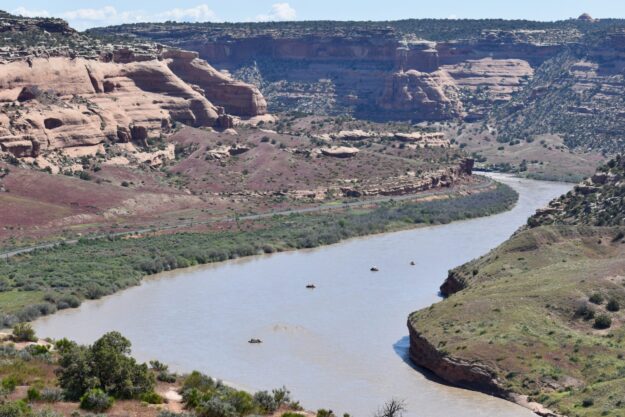Widgetized Section
Go to Admin » Appearance » Widgets » and move Gabfire Widget: Social into that MastheadOverlay zone
State sounds alarm as Colorado River now home to invasive zebra mussel larvae

Rafters float down the Colorado River in Horsethief Canyon near the Colorado-Utah border on May 15, 2023 (Chase Woodruff/Colorado Newsline).
Colorado Parks and Wildlife officials have launched an extensive monitoring and public outreach plan following the detection of invasive zebra mussel larvae in several locations along the Colorado River near Grand Junction last month. But their next steps will depend on what they learn about the extent and the source of the invasive population, which could pose an “extreme risk” to local ecosystems and water utilities.
“If they are in a small pond, as an example, there is a completely different arsenal of tools that we may have in our tool belt to try to address that situation than if they are in an open water system like the Colorado River,” Robert Walters, CPW’s invasive species program manager, told a committee of state lawmakers on Wednesday. “Until we identify the source of the population, it’s really difficult to say what those control options might be.”
Zebra mussels are dangerous to water ecosystems because they strip plankton, an essential food source, from the water. Additionally, they can threaten water supplies and irrigation systems by impeding or stopping water flows and attaching to infrastructure, causing millions of dollars in damages and increased maintenance costs.
The fingernail-sized mussels, which are native to the Black and Caspian seas, are “almost impossible to eradicate” once a population is established, CPW officials say. The species has impacted ecosystems in the Great Lakes region since the late 1980s, and has subsequently spread throughout many parts of the United States by attaching to boats and other aquatic equipment.
Walters said that after additional sampling in the last few weeks, the agency now considers the Colorado River to be “positive” for zebra mussels. CPW previously deemed the river and the Government Highline Canal, a 55-mile-long irrigation project that diverts some of the river’s water to farms in the Grand Valley, “suspect” after initial testing detected zebra mussel DNA in early July. The total number of locations where the species has been detected is now seven.
“Our focus now is really on the monitoring,” Walters said. “We want to know where these are coming from and how far they have spread here in the state, as that is going to influence our long-term planning.”
The agency is coordinating its response with the U.S. Fish and Wildlife Service and the U.S. Bureau of Reclamation, which owns the Highline Canal, along with the Army Corps of Engineers, which is conducting a “west-wide boater movement study” to identify how and where contaminated boats may have entered Colorado waterways. Public awareness campaigns and a network of inspection and decontamination stations at popular boating sites are key prevention strategies, Walters said. A 10-second high-pressure spray of hot water is enough to kill and remove zebra mussels that have attached to a boat.
CPW urges anyone using the Colorado River to clean, drain, and dry their vessels and equipment — including boats, rafts, kayaks, paddle boards and fishing equipment — after they leave the water.
So far, no adult zebra mussels have been found in the Colorado River, Walters said — only so-called veligers, the species’ larval form. Public education and awareness will be critical to minimizing the impacts of what for now is a “very low density of veligers that we are detecting,” he said.
“We have had zero positive detection since those last ones in the middle of July,” Walters added. “That doesn’t mean we aren’t continuing to look. We are out there every single week collecting additional samples, trying to identify where these are coming from.”
Editor’s note: This story first appeared on Colorado Newsline, which is part of States Newsroom, a nonprofit news network supported by grants and a coalition of donors as a 501c(3) public charity. Colorado Newsline maintains editorial independence. Contact Editor Quentin Young for questions: info@coloradonewsline.com. Follow Colorado Newsline on Facebook and X.
Chase Woodruff
Latest posts by Chase Woodruff (see all)
- Evans, Boebert defend Medicaid cuts as protesters shout them down in Denver - May 30, 2025
- Colorado officials envision Mountain Rail by 2026, Denver to Boulder to Fort Collins by 2029 - May 19, 2025
- Colorado’s Evans votes in favor of bill that will kick at least 7.6 million people off Medicaid coverage - May 15, 2025


